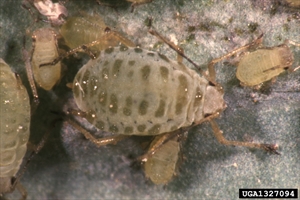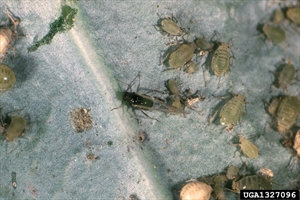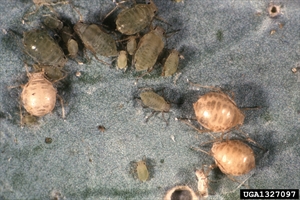Cabbage aphid, mustard aphid, turnip aphid.
Pacific Pests, Pathogens, Weeds & Pesticides - Online edition
Pacific Pests, Pathogens, Weeds & Pesticides
Cabbage (mustard) aphid (332)
Lipaphis erysimi, previously known as Lipaphis pseudobrassicae and Rhopalosiphum pseudobrassicae.
Asia, Africa, North, South and Central America, the Caribbean, Europe, Oceania. It is recorded from Australia, Fiji, Guam, New Zealand, Papua New Guinea, and Solomon Islands.
Mainly plants in the cabbage family, Brassica (broccoli, cabbage, cauliflower, Indian mustard), Raphanus (radish), Sinapis species (white mustard), and cruciferous weeds.
The aphid lives in dense groups on the underside of the leaves, sucking the sap. The main symptoms are curling and yellowing of leaves, and stunting. Honeydew is produced and this drips onto the leaves below and is colonised by sooty mould fungi. Viruses are spread during feeding,
Adults are about 1.7 mm long, with both winged and wingless types. Wingless are greenish-yellow, covered in a fine waxy coating, with green bands on the top of the body (Photo 1). The antennae are dark. Winged types have shiny black heads and prothorax (the segment in front of the thorax), and green abdomens (Photo 2). Males are known in Europe, India, New Zealand, but, where warmer, females give birth to living young without mating.
When populations increase some aphids are born with wings allowing them to move to other plants in the field or to other fields. Spread over longer distances occurs in wind currents.
The direct damage caused by the aphid can be considerable. In India, mustard is especially susceptible with instances of over 90% reduction in yield. Honeydew production by the aphid, and its colonisation by fungi, reduces market value of cabbages and other species. Many viruses are spread by the aphid, including the economically important Bean yellow mosaic virus, Cauliflower mosaic virus, Celery mosaic virus, Cucumber mosaic virus (see Fact Sheet no. 100), Potato virus Y, Turnip mosaic virus (see Fact Sheet no. 99). Spread of viruses by the aphid is possibly more important than the direct damage done by feeding.
Look for the aphids on the undersides of the leaves. Look for the aphids with greyish-green bodies, covered with powder and with distinctive bands along the body.
NATURAL ENEMIES
Aphid populations are controlled by environmental factors, parasitic wasps (Photo 3), fungal diseases, ladybird beetles, syrphid fly larvae, and lacewing larvae and adults. Many parasitoid wasps have been reported with Diaeretiella rapae, Aphidius and Aphelinus species, the most common. Aphidus species create swollen, tan and papery 'mummies', whereas Aphelinus species leave black mummies. The parasitoids within the mummies of Photo 3 are unknown.
Note, ants tend aphids for their honeydew. By doing so, they protect the aphids from the activities of parasites and predators. To manage aphids, it is important to remove the ants, to let biological control operate.
CULTURAL CONTROL
Methods have been tried, e.g., changing planting times, intercropping, altering spacing, but none have provided useful results.
Before planting:
- Do not plant down-wind from crops with aphids. Some aphids have wings, but they are not strong fliers, and are more likely to be blown in the wind onto new crops.
During growth:
- Remove weeds from within and also outside the crop, especially cruciferous weeds.
- Inspect crops often and regularly; destroy leaves heavily infested with aphids by hand (or if necessary use insecticides - see below).
- If ants are present, find the nest, and destroy it with boiling water, if practical and plants are not at risk of damage, or use a pesticide (see below). Without ants, predators and parasites will bring about natural control.
After harvest:
- Collect, burn or bury the remains of crops after harvest.
CHEMICAL CONTROL
If insecticides are necessary, use any of the following 'soft' insecticides on aphids:
- Soap sprays (5 tablespoons of soap in 4 litres water).
- Vegetable oil (1 cup cooking oil; 2 cups water; 1 teaspoon dishwashing liquid. Dilute the mixture at 3 teaspoons per half litre of water and spray on the infested leaves).
- Commercial products with petroleum oil: follow the instructions on the product label.
These sprays work by blocking the breathing holes of insects causing suffocation and death. Spray the underside of leaves, as the soap and oils must contact the aphids. Home-made preparations are ideal for small numbers of plants, but commercial products are probably the only practical solution when crop areas are large.
Alternatively, use:
- Plant-derived products, such as neem, derris, pyrethrum and chilli (with the addition of soap).
- Note, varieties of Derris exist in Papua New Guinea and Solomon Islands that contain 2-3% rotenone, and are effective insecticides. However, they should be used with caution. (For methods of preparation, see Fact Sheet no. 56.) Check if Derris is available locally in your country.
- Synthetic pyrethroids are likely to be effective, but will also kill natural enemies. However, they can be used to kill ants, which often tend aphids for their honeydew, and protect them from effective control by predators and parasitoids.
____________________
When using a pesticide, always wear protective clothing and follow the instructions on the product label, such as dosage, timing of application, and pre-harvest interval. Recommendations will vary with the crop and system of cultivation. Expert advice on the most appropriate pesticides to use should always be sought from local agricultural authorities.
AUTHOR Grahame Jackson
Information from CABI (2017) Lipaphis erysimi (mustard aphid). Crop Protection Compendium. (www.cabi.org/cpc); and Lipaphis erysimi (Kaltenbach) (2007) Crop Knowledge Master Department of Entomology, Honolulu, Hawaii. (http://www.extento.hawaii.edu/kbase/crop/type/lipaphis.htm); and from MAF (New Zealand) Plant Health & Environment (2011) Turnip Aphid (Lipaphis erysimi): PaDIL - (http://www.padil.gov.au). Photo 1-3 Alton N. Sparks, Jr., University of Georgia, Bugwood.org. Photo 4 Caroline Smith, University of Tasmania, Australia.
Produced with support from the Australian Centre for International Agricultural Research under project PC/2010/090: Strengthening integrated crop management research in the Pacific Islands in support of sustainable intensification of high-value crop production, implemented by the University of Queensland and the Secretariat of the Pacific Community.






